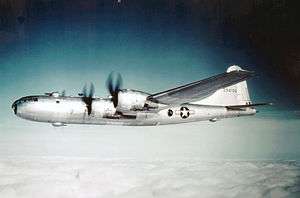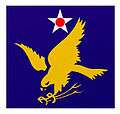472d Bombardment Group
| 468th Bombardment Group | |
|---|---|
 B-29 Superfortress as flown by the group[note 1] | |
| Active | 1943–1944 |
| Country |
|
| Branch |
|
| Role | Bombardment |
| Part of | Second Air Force |
The 472d Bombardment Group is an inactive United States Air Force unit. It was last assigned to the Second Air Force, being stationed at Clovis Army Airfield, New Mexico. It was inactivated on 1 April 1944.
The group served as the initial Operational Training Unit (OTU) for prototype B-29 Superfortress aircraft as part of the 58th Bombardment Wing. After the wing deployed to India, it was involved in training B-29 crews in New Mexico and took part in early testing of the B-29 to carry the Atomic Bomb.
History
The group was activated on 1 September 1943 at Smoky Hill Army Air Field, Kansas. The 808th, 809th, 810th and 811th Bombardment Squadrons were simultaneously activated and assigned to the group. Although the 472d's mission was to train aircrews on the Boeing B-29 Superfortress, the squadrons also flew Boeing B-17 Flying Fortresses.[1][2] The group was assigned to the 58th Bombardment Wing, which returned to Smoky Hill from Marietta Army Air Field in the middle of the month. The 472nd Bombardment Group was to be the initial group to receive the prototype YB-29 and first production B-29 Superfortresses.
President Roosevelt wanted B-29 bombing raids against Japan to start by January 1944. However, delays in the B-29 program forced General Arnold to admit to the president that the bombing campaign against Japan could not begin until May 1944 at the earliest. The crews of the B-29 needed a degree of specialist training that was not required for crews of other, less complex aircraft. It usually took 27 weeks to train a pilot, 15 to train a navigator, and 12 to train a gunner. The complexity of the B-29 was such that a lengthy process of crew integration had to take place before combat deployment could begin. By the end of December 1943, only 73 pilots had qualified for the B-29 and very few crews had been brought together as a complete team.
After the initial groups of the 58th Wing completed conversion training on the B-29, the 472d and its squadrons moved to Clovis Army Air Field, New Mexico about 7 December 1943 to begin training follow-on B-29 crews. However the group also was involved in secret testing of the B-29 for suitability in carrying Atomic Bombs, which were being developed at Los Alamos, New Mexico.
With these initial tests completed, and the B-29 crew training program well underway, the group was inactivated on 1 April 1944.
Lineage
- Constituted as the 472nd Bombardment Group (Heavy) on 19 May 1943
- Activated on 1 September 1943
- Redesignated 472nd Bombardment Group, Very Heavy on 1 December 1943
- Disbanded on 1 April 1944[1]
Assignments
- 58th Bombardment Wing, 1 September 1943 – 1 April 1944[3]
Operational Units
- 808th Bombardment Squadron, 1 September 1943 – 1 April 1944[1][2]
- 809th Bombardment Squadron, 1 September 1943 – 1 April 1944[1][2]
- 810th Bombardment Squadron, 1 September 1943 – 1 April 1944[1][2]
- 811th Bombardment Squadron, 1 September 1943 – 1 April 1944[1][2]
Stations
- Smoky Hill Army Air Field , Kansas, 1 September 1943
- Clovis Army Air Field, New Mexico, 7 December 1943 – 1 April 1944[1]
Aircraft
References
Notes
- Explanatory notes
- ↑ Aircraft is Boeing B-29A-30-BN Superfortress, serial 42-94106.
- Citations
Bibliography
![]()
- Maurer, Maurer, ed. (1983) [1961]. Air Force Combat Units of World War II (PDF) (reprint ed.). Washington, DC: Office of Air Force History. ISBN 0-912799-02-1. LCCN 61060979. Retrieved December 17, 2016.
- Maurer, Maurer, ed. (1982) [1969]. Combat Squadrons of the Air Force, World War II (PDF) (reprint ed.). Washington, DC: Office of Air Force History. ISBN 0-405-12194-6. LCCN 70605402. OCLC 72556. Retrieved December 17, 2016.
- Further reading
